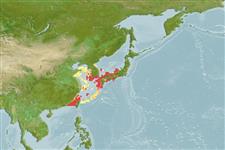Classification / Names
Common names from other countries
Main reference
Size / Weight / Age
Max length : 32.0 cm TL male/unsexed; (Ref. 593)
Length at first maturity
Lm ?, range 15 - ? cm
Environment
Marine; brackish; pelagic-neritic; oceanodromous (Ref. 51243)
Climate / Range
Subtropical, preferred 16°C (Ref. 107945); 42°N - 23°N, 117°E - 138°E (Ref. 54453)
Distribution
Indo-West Pacific: coasts of Japan from about 38°N southward; Sea of Japan north to Vladivostok on mainland; also Yellow Sea, including Gulf of Pohai and East China Sea south to Taiwan Island and Hong Kong).
Countries | FAO areas | Ecosystems | Occurrences | Introductions
Short description
Dorsal
spines
(total): 0;
Anal
spines: 0;
Anal
soft rays: 192 - 27. Body moderately slender, moderately compressed, belly with 17 to 21 (usually 19 or 20) + 12 to 16 (usually 14 or 15), total 32 to 37 (usually 34 or 35) scutes; no pre-dorsal scutes. Snout projecting slightly; gill rakers of first arch at least 3/4 length of gill filaments. Vertebrae 46 to 51 (usually 49, also 48 or 51). A dark spot behind gill opening, followed by several lines of dark dots.
IUCN Red List Status (Ref. 115185)
Threat to humans
Harmless
Human uses
Fisheries: minor commercial
More information
ReferencesAquacultureAquaculture profileStrainsGeneticsAllele frequenciesHeritabilityDiseasesProcessingMass conversion
Tools
Special reports
Download XML
Internet sources
Estimates of some properties based on models
Phylogenetic diversity index
PD50 = 1.0000 many relatives (e.g. carps) 0.5 - 2.0 few relatives (e.g. lungfishes)
Trophic Level
2.9 ±0.22 se; Based on food items.
Resilience
High, minimum population doubling time less than 15 months (Assuming tm=1)
Vulnerability
Moderate vulnerability (36 of 100)
Price category
